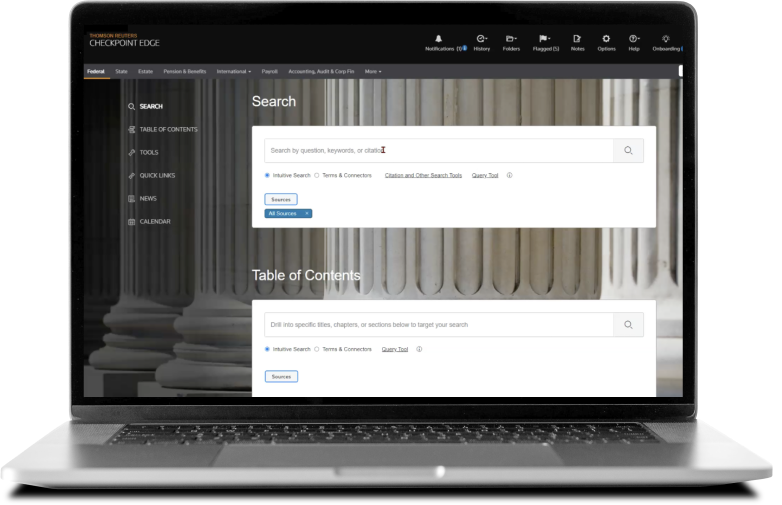Jump to:
| What are the sources of tax law? |
| Analyzing tax authorities |
| Making the business case for generative AI tax research software |
As a tax and accounting advisor, your practice depends on keeping pace with today’s complex regulatory environment. Taking and defending tax positions, responding to questions, and strategically advising your client or organization require solid research and validation.
Staying on top of change is easier said than done, given that tax and accounting professionals both in-house and within accounting firms report that they are faced with time pressure, increasing client demands, and staffing constraints. Access to easy-to-use and credible tax research sources is therefore critical: both primary sources of tax law and authoritative secondary sources of comment and guidance.
However, many tax professionals find research a difficult and time-consuming task, even when working with authoritative research tools. Because tax research is a skill often learned on the job, junior staff in particular struggle to find answers efficiently, especially when working in unfamiliar topic areas. Some may turn to Google as a quick, familiar, and free option; or occasionally a general-purpose, publicly available generative AI platform.
These options each bring their own risks in terms of accuracy, currency, and lack of authority – not to mention significant privacy and security concerns (especially in relation to client or organizational data) – which multiply the potential financial and reputational impacts arising from unvetted tax research.
Today, however, it is possible to combine ease of use, security and trustable answers, by using an AI-powered, industry-specific tax research solution that leverages up-to-date content and ensures only reliable search results from authoritative primary and secondary tax law sources – a professional-grade tool designed for specialists in tax.
Let’s take a closer look at how tax and accounting professionals can spend less time on tax research by harnessing the power of AI for enhanced accuracy, quality, and efficiency.
What are the sources of tax law?
Primary tax authority comes from statutory, administrative, and judicial sources including, but not limited to, the Internal Revenue Code, Revenue Rulings, the Financial Accounting Standards Board, the US Tax Courts and Supreme Court, Treasury Regulations, international tax treaties and so on. However, understanding what primary law applies in a given situation is just the beginning. Secondary information sources of various kinds include IRS publications, tax journals and newsletters, commercial tax research services and a welter of blogs, newsletters, and guidance produced by various advisory organizations and businesses.
Analyzing tax authorities
Once researchers have found their tax research sources, prioritized the ones they wish to rely on and discarded the rest, they must assess and analyze the sources to both understand the law and to determine whether it applies to the fact pattern/scenario they are working on. This can be the most time-consuming and challenging aspect of the tax research process, because tax law is not often straightforward. It can also be difficult determining when you’ve researched enough and uncovered all the necessary pieces.
Finally, this information must be assimilated and combined into whatever output is required. Looking up a single tax rate for a specific entry on a return is one thing. Producing a brief on the advantages and disadvantages of various tax positions to support a business restructuring is something else.
Failing to complete this foundational work to a high standard is not an option, given the professional, organizational and financial risks involved. However, with many tax professionals ill-equipped to formulate well-executed searches, and lacking time to sift through results and conduct thorough reading, inefficient research processes become a drag on time, productivity, and morale.
Making the business case for generative AI tax research software
Given today’s complex regulatory environment, rise in client expectations, and ongoing staffing constraints, it is more important than ever to use up-to-date tools to ensure you are getting information from quality tax sources as easily and quickly as possible.
Enter Checkpoint Edge with CoCounsel, a professional grade, generative AI tax research assistant that ensures fast, easy-to-read responses grounded in citations to reliable and vetted sources. The tool synthesizes expertly written and easy-to-understand guidance and analysis at a stroke, drawing on thousands of primary sources and expert editorial commentary to quickly surface relevant summaries for your issue.
Tax and accounting professionals are using Checkpoint Edge with CoCounsel to:
- Save time on internal processes. Accelerate results by getting a faster start to your research with easy-to-understand responses and quick validation. Vet tax positions, tackle questions, and empower junior staff to upskill themselves.
- Increase productivity. Conquer complex tax questions faster than ever. Bolster tax and accounting knowledge without poring over multiple references and layers of content. Get to the trusted sources you need faster.
- Improve communication. Answer questions more quickly while providing fast and accurate insights, enhancing the way information is delivered and decisions are made.
Tax and accounting professionals across all levels and disciplines gain newfound confidence in research, while senior colleagues dedicate more time to advancing strategic priorities. For more tips on making the business case for AI-powered tax research software, read “Why pay for a tax research tool?”
 |
Checkpoint Edge featuresPowered by AI and machine learning, Checkpoint Edge with CoCounsel returns targeted search results in less time. |









